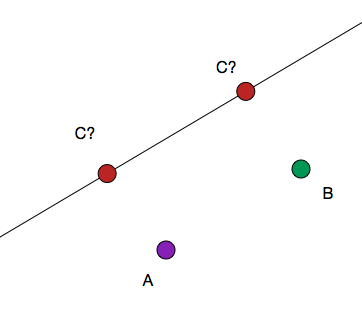Warm up problem: Cartesian Right Triangle 2 (harder)

here is a link to the easier one
Given point A=(1,6) and B=(4,12) and line D=3x+7, a point C is placed on line D such that is a right triangle. If the sum of all possible x-coordinates of c can be represented by . Find p+q.
Tip: the right angle doesn't necessarily occur at A or B.
The answer is 319.
This section requires Javascript.
You are seeing this because something didn't load right. We suggest you, (a) try
refreshing the page, (b) enabling javascript if it is disabled on your browser and,
finally, (c)
loading the
non-javascript version of this page
. We're sorry about the hassle.
Using vectors and scalar dot products is probably the easiest way to approach this problem.
We will have 4 possible scenarios for point C ( x , 3 x + 7 ) , (noting that by, for example, < A C > I mean the vector from A to C and by " ⋅ " I mean the dot product operation):
(i), (ii): < A C > ⋅ < B C > = 0
⟹ < x − 1 , 3 x + 1 > ⋅ < x − 4 , 3 x − 5 > = 0
⟹ ( x − 1 ) ( x − 4 ) + ( 3 x + 1 ) ( 3 x − 5 ) = 0
⟹ 1 0 x 2 − 1 7 x − 1 = 0 ,
the two roots of which add to 1 0 1 7 .
(iii) < A C > ⋅ < A B > = 0
⟹ < x − 1 , 3 x + 1 > ⋅ < 3 , 6 > = 0
⟹ 3 x − 3 + 1 8 x + 6 = 0 ⟹ 2 1 x = − 3 ⟹ x = − 7 1 .
(iv) < B C > ⋅ < A B > = 0
⟹ < x − 4 , 3 x − 5 > ⋅ < 3 , 6 > = 0
⟹ 3 x − 1 2 + 1 8 x − 3 0 = 0 ⟹ x = 2 .
So the sum of all possible x -coordinates will be
1 0 1 7 − 7 1 + 2 = 7 0 2 4 9 .
Thus p = 2 4 9 , q = 7 0 and p + q = 3 1 9 .